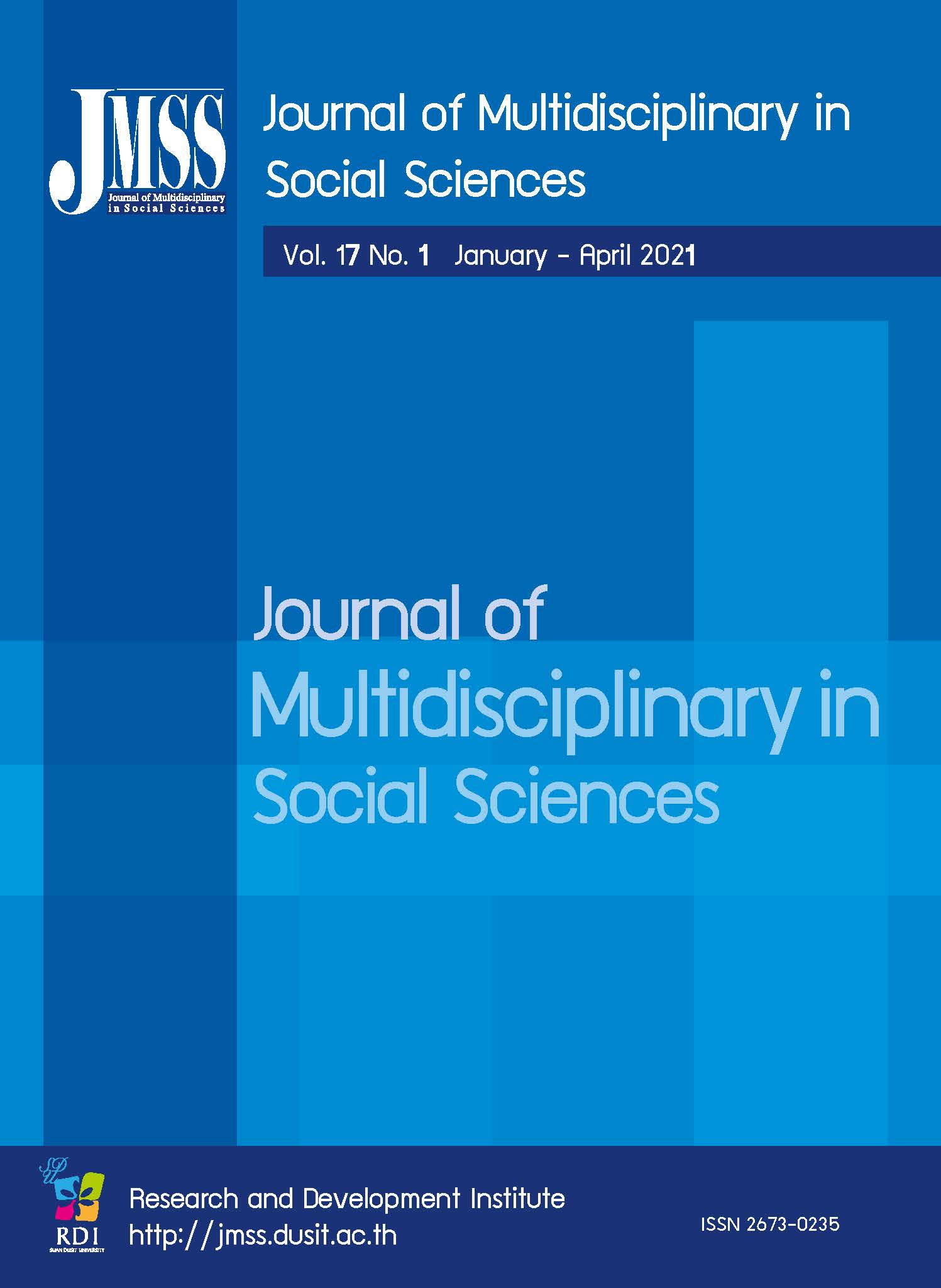Factors Influencing Thai Tourists' Decision Making to Choose Dvaravati Civilization for Tourist Attractions
Keywords:
Dvaravati Civilization-based, Tourist behavior, TouristAbstract
The objective of this research was to study tourist behavior of Dvaravati civilization-based tourist attractions and find ways to develop tourist behavior of Dvaravati civilization-based tourist attractions. The researcher conducted a random survey of 18,361,221 tourists who visited the Dvaravati Civilization-based tourist attractions. The sample group consisted of 400 Thai tourists aged 20-60 years. Statistical tools used in the data analysis included percentage, mean and standard deviation Cronbach's Alpha was used to assess the reliability of the questionnaire scored at 0.980. Multiple regression analysis was also used to test the correlation among the variables.
The findings showed overall opinions of tourists toward tourism behavior of Dvaravati civilization-based tourist attractions were at a high level in all aspects. For each aspect, it was found that reputation of tourist attractions was ranked first, followed by rank two asthe beauty of the tourist attractions and third rank was the value of tourism. Whereas tourism services and facilities were ranked the lowest. As for the relationship with the Dvaravati Civilization-based tourist attraction management, it was found that the relationship was at a high level of 0.601, and factors influencing Thai tourists' decision making to choose Dvaravati civilization affects the potential of Dvaravati civilization-based tourist attractions with a 0.05 level of significance level. As a result, the prediction was presented in the Equation: ŷ = 1.011 + (0.391Rta) + (0.184Bta) + (0.089Vot) + (0.103Tsf).
References
Al-Ababneh, Mukhles. (2013). Service Quality and its Impact on Tourist Satisfaction. Interdisciplinary Journal of Contemporary Research in Business 4 (12): 164–177
Andrews, J. C., Akhter, S. H., Durvasula, S, &Muehling, D. (1992). The effects of advertising distinctiveness and message content involvement on cognitive and affective responses to advertising. Journal of Current Issues and Research in Advertising.
Canny, I. U. (2013). An empirical investigation of service quality, tourist satisfaction and future behavioral intentions among domestic local tourist at Borobudur Temple. Retrieved from http://www.ijtef.org/papers/265-F603.pdf
Cohen, S. A., Prayag, G. and Moital, M. (2014). “Consumer behaviour in tourism: Concepts, influences and opportunities”. Current Issues in Tourism, Vol. 17, No 10, p. 872-909.
Cooper, C., & Hall, M. (2008). Contemporary Tourism: An International Approach. London, ButterworthHeinemann.
Dellaert, B.G.C., Arentze, T.A. and Horeni, O. (2014). Tourists' mental representations of complex travel decision problems. Journal of Travel Research, Vol. 53 , 3-11.
Dickman, S. (1996).Tourism: An Introductory Text. 2nd ed. Sydney: Hodder Education.
Hair et al. (2009). Multivariate Data Analysis. (7th Edition) Prentice Hall.
Kasikornbank. (2019). Thailand's Tourism Industry Outlook 2019. Retrieved January 22, 2020 from https://kasikornbank.com/international-business/en/Thailand/IndustryBusiness/Pages/201901_Thailand_TourismOutlook19.aspx
Kotler, P., Bowen, J. and Makens, J. (1999). Marketing for Hospitality and Tourism, 2nd ed., Prentice Hall, USA.
Lamaichin, K. (2009). Tourism Elements. Ubon Ratchathani: Ubon Ratchathani Rajabhat University.
Ministry of Tourism and Sports. (2018, April). Domestic Tourist Statistics 2018. Retrieved March 22, 2019 from https://www.mots.go.th/more_news.php?cid=509&filename=index
NetherlandsEmbassy in Bangkok. (2020). Tourism industry in Thailand. Retrieved January 22, 2020 from https://www.rvo.nl/sites/default/files/2017/06/factsheettoerisme-in-thailand.pdf.
Nejati and Mohamed. (2015). Investigating the key factors influencing the travel decisions of International Tourist, 31-33.
Ninemeier, J. D., & Perdue, J. 2008. Discovering Hospitality and Tourism: The World’s Greatest Industry. 2nd ed, New Jersey, Pearson Prentice Hall.
Papatheodorou, A. (2006). Managing Tourism Destinations. Northampton, Edward Elgar Publishers.
Petrick, J. F. (2002). Development of multi-dimensional scale for measuring the perceived value of a service. Journal of Leisure Research, 34 (2), 119-134.
Poon, A., (1994). Tourism, Technology and Competitive Strategies. Cab International
Salim, H. (2015). Tourist Behavior and its Role in Determining the Pattern of Tourism. Journal of Economic and Administrative Sciences, 3(48), 63-80.
Schiffman, L., and L. L. Kanuk. (2008). Perilaku Konsumen. Indeks, Jakarta
Schiffman, L. G., O'Cass, A., Paladino, A., & Carlson, J. (2014). Consumer behaviour. (6th ed.). Frenchs Forest NSW: Pearson Australia.
Seyidov J, Adomaitiene R. (2016). Factor’s influencing local tourists’ decision making on choosing a destination: A case of Azerbaijan. Economics. 95(3):112-127.
Smallman, C., & Moore, K. (2010). Process studies of tourists’ decision-making. Annals of Tourism Research, 37(2), 397-422.
Li, X., Li, X. R. in Hudson, R. (2013). The application of generational theory to tourism consumer behavior:An American perspectiveTourism Management 37, pp: 147-164
thaiwebsites.com. (2020). Dvaravati Culture. Retrieved January 22, 2020 from http://www.thaiwebsites.com/dvaravati.asp
Tourism Western Australia. (2008). Five A’s of Tourism. Retrieved Sep 25, 2020, from https://pgimgmt.com/developing-successful-and-sustainable-tourismdestinations-based-on-the-5-as-of-tourism.
Williams, A. (2006). Tourism and hospitality marketing: fantasy, feeling and fun. International Journal of Contemporary Hospitality Management, 18, 482–495.
Yoona, Y., Uysal, M. (2005). An Examination of the Effects of Motivation and Satisfaction on Destination Loyalty: A Structural Model. Tourism Management, 26 (1), 45-56. http://dx.doi.org/10.1016/j.tourman.2003.08.016.
Downloads
Published
How to Cite
Issue
Section
License

This work is licensed under a Creative Commons Attribution-NonCommercial-NoDerivatives 4.0 International License.








